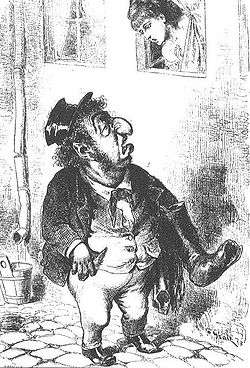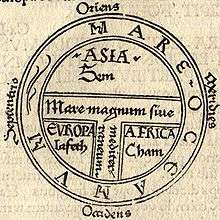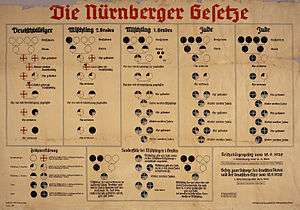Racial antisemitism

| Part of a series on |
| Antisemitism |
|---|
 Part of Jewish history |
|
Antisemitism on the Web |
|
Opposition |
|
|
Racial antisemitism is antisemitism or prejudice against Jews on the basis of Jews being a racial or ethnic group, rather than prejudice against Judaism as a religion.[1] The definition is based on the premise that Jews constitute a distinctive race or ethnic group, whose traits or characteristics are in some way abhorrent or inherently inferior or otherwise different to that of the rest of society. The abhorrence may be expressed in the form of stereotypes or caricatures. Racial antisemitism may present Jews, as a group, as being a threat in some way to the values or safety of society.
According to William Nichols, religious antisemitism may be distinguished from modern antisemitism based on racial or ethnic grounds. "The dividing line was the possibility of effective conversion . . . a Jew ceased to be a Jew upon baptism." However, with racial antisemitism, "Now the assimilated Jew was still a Jew, even after baptism ... . From the Enlightenment onward, it is no longer possible to draw clear lines of distinction between religious and racial forms of hostility towards Jews... Once Jews have been emancipated and secular thinking makes its appearance, without leaving behind the old Christian hostility towards Jews, the new term antisemitism becomes almost unavoidable, even before explicitly racist doctrines appear."[2]
In the context of the Industrial Revolution, following the emancipation of the Jews and the Haskalah (the Jewish Enlightenment), Jews rapidly urbanized and experienced a period of greater social mobility. With the decreasing role of religion in public life tempering religious antisemitism, a combination of growing nationalism, the rise of eugenics, and resentment at the socio-economic success of the Jews soon led to the newer, and often more virulent, racist antisemitism.[3]
The logic of racial antisemitism was extended in Nazi Germany, where racial antisemitic laws were enshrined into law, which looked at the "blood" or ethnicity of a person, and not their current religious affiliations, and their fate would be determined purely on that basis. When added to its views on the Jewish racial traits which the Nazi pseudoscience devised, led to the Holocaust as a way of eradicating conjured up "Jewish traits" from the world.
Limpieza de sangre
A first appearance of racial antisemitism can be found in the Middle Ages alongside religious antisemitism. Though the limpieza de sangre ("purity of blood") laws of medieval Spain and New Spain affected all non-Christians in society, it had particular impact on Jewish converts to Catholicism who continued to bear some of the disabilities to which they had previously been subject, and even grandchildren of a convert (who may even not know of the heritage) could be stigmatized for their "inferior" blood. The laws tainted Jewish converts to Catholicism, who were denied equal rights and status as Christians, This inferior status continued to apply to the convert's descendants, whose sincerity to their new faith was always in question before the Inquisition, and always had to be able to prove their blood line.
Racial antisemitism has existed alongside religious antisemitism since the Middle Ages, if not earlier. In Spain even before the Edict of Expulsion of 1492, Spanish Jews who converted to Catholicism (conversos in Spanish), and their descendants, were called New Christians. They were frequently accused of lapsing to their former religious practices ("Crypto-Jews"). To isolate conversos, the Spanish nobility developed an ideology of "cleanliness of blood". The conversos were called "New Christians" to indicate their inferior status in society. That ideology was a form of racism, as in the past there were no grades of Christianity and a convert had equal standing. Cleanliness of blood was an issue of ancestry, not of personal religion. The first statute of purity of blood appeared in Toledo in 1449,[4] where an anti-converso riot lead to conversos being banned from most official positions. Initially these statutes were condemned by the monarchy and the Church. However, the New Christians came to be hounded and persecuted by the Spanish Inquisition after 1478, the Portuguese Inquisition after 1536, the Peruvian Inquisition after 1570 and the Mexican Inquisition after 1571, as well as the Inquisition in Colombia after 1610.
In Portugal, the legal distinction between "New" and "Old" Christians continued until the issue of a legal decree by the Marquis of Pombal in 1772.
Nationalism and antisemitism
Racial antisemitism was preceded, especially in Germany, by antisemitism arising from Romantic nationalism. As racial theories developed, especially from the mid nineteenth-century onwards, these nationalist ideas were subsumed within them. But their origins were quite distinct from racialism. On the one hand they derived from an exclusivist interpretation of the 'Volk' ideas of Johann Gottfried Herder. This led to antisemitic writing and journalism in the second quarter of the 19th century of which Richard Wagner's Das Judentum in der Musik (Jewry in Music) is perhaps the most notorious example. On the other hand, radical socialists such as Karl Marx (himself of Jewish descent) identified Jews as being both victims and enforced perpetrators of the Capitalist system – e.g. in his article On the Jewish Question. From sources such as these, and encouraged by the broad acceptance of racial theories as the century continued, antisemitism entered the vocabularies and policies of both the right and the left in political thought.
Germany experienced strong industrial growth following its unification in 1871. Romantic nostalgia coalesced with the rising industrial middle class to form the Völkisch movement. Proponents became concerned with race: pre-Christian German pagan traditions and customs. Terms such as "teutonic" and "aryan" entered the vocabulary. Industrialist Theodor Fritsch financed publication of texts such as The Protocols of the Elders of Zion and reprints of Henry Ford's "The International Jew." The Germanenorden of 1912 was one such party to emerge from this movement.
Concept of a "semitic race"

In Medieval Europe, all Asian peoples were thought of as descendants of Shem. By the 19th century, the term Semitic was confined to the ethnic groups who have historically spoken Semitic languages or had origins in the Fertile Crescent, as the Jews in Europe did. These peoples were often considered to be a distinct race. However, some antisemitic racial theorists of the time argued that the Semitic peoples arose from the blurring of distinctions between previously separate races. This supposed process was referred to as semiticization by the race-theorist Arthur de Gobineau. The notion that Semitic identity was a product of racial "confusion" was later taken up by the Nazi ideologue Alfred Rosenberg.[5]
Semiticization is a concept found in the writings of some racial theorists in the nineteenth and twentieth centuries. The term was first used by Gobineau to label the blurring of racial distinctions that, in his view, had occurred in the Middle East. Gobineau had an essentialist model of race according to which there were three distinct racial groups: "black", "white" and "yellow" peoples, though he had no clear account of how this division arose. When these races mixed this caused "degeneration". Since the point at which these three supposed races met was in the Middle East, Gobineau argued that the process of mixing and diluting races occurred there, and that Semitic peoples embodied this "confused" racial identity.
This concept suited the interests of antisemites, since it provided a theoretical model to rationalise racialised antisemitism. Variations of the theory are to be found in the writings of many antisemites in the late 19th century. The Nazi ideologue Alfred Rosenberg developed a variant of the theory in his writings, arguing that Jewish people were not a "real" race. According to Rosenberg, their evolution came about from the mixing of pre-existing races rather than from natural selection. The theory of semiticization was typically associated with other longstanding racist fears about the dilution of racial difference through miscegenation, manifested in negative images of mulattos and other mixed groups.
The rise of racial antisemitism
Modern European antisemitism has its origins in 19th century theories—now mostly considered as pseudo-scientific—that said that the Semitic peoples, including the Jews, are entirely different from the Aryan, or Indo-European, populations, and that they can never be amalgamated with them. In this view, Jews are not opposed on account of their religion, but on account of their supposed hereditary or genetic racial characteristics: greed, a special aptitude for money-making, aversion to hard work, clannishness and obtrusiveness, lack of social tact, low cunning, and especially lack of patriotism. Later, Nazi propaganda also dwelt on supposed physical differences, such as the shape of the "Jewish nose".[6][7][8][9]
While enlightened European intellectual society of that period viewed prejudice against people on account of their religion to be declassé and a sign of ignorance, because of this supposed 'scientific' connection to genetics they felt fully justified in prejudice based on nationality or 'race'. In order to differentiate between the two practices, the term antisemitism was developed to refer to this 'acceptable' bias against Jews as a nationality, as distinct from the 'undesirable' prejudice against Judaism as a religion. Concurrently with this usage, some authors in Germany began to use the term 'Palestinians' when referring to Jews as a people, rather than as a religious group. Similar custom is still displayed in the use in academic circles of the term "Hebrew" in preference to the term "Jewish".
Actually, it is questionable whether Jews looked significantly different from the general population in which they lived. This was especially true in places like Germany, France and Austria where the Jewish population tended to be more secular (or at least less Orthodox) than that of Eastern Europe, and did not wear clothing (such as a yarmulke) that would particularly distinguish their appearance from the non-Jewish population. Many anthropologists of the time such as Franz Boas tried to use complex physical measurements like the cephalic index and visual surveys of hair/eye color and skin tone of Jewish vs. non-Jewish European populations to prove that the notion of separate "Jewish" and "Aryan" races was a myth. The 19th and early 20th century view of race should be distinguished from the efforts of modern population genetics to trace the ancestry of various Jewish groups, see Y-chromosomal Aaron.
The advent of racial antisemitism was also linked to the growing sense of nationalism in many countries. The nationalist context viewed Jews as a separate and often "alien" nation within the countries in which Jews resided, a prejudice exploited by the elites of many governments.
Racial antisemitic legislation

In Nazi Germany, the Nuremberg Race Laws of 1935 prohibited sexual relations and marriage between any Aryan and Jew (such relations under Nazi ideology was a crime punishable under the race laws as Rassenschande or "racial pollution"), and made it that all Jews, even quarter- and half-Jews, were no longer citizens of their own country (their official title became "subject of the state"). This meant that they had no basic citizens' rights, e.g., to vote. In 1936, Jews were banned from all professional jobs, effectively preventing them having any influence in education, politics, higher education and industry. On 15 November 1938, Jewish children were banned from going to normal schools. By April 1939, nearly all Jewish companies had either collapsed under financial pressure and declining profits, or had been persuaded to sell out to the Nazi government. This further reduced their rights as human beings; they were in many ways officially separated from the German populace. Similar laws existed in Bulgaria- The Law for protection of the nation, Hungary, Romania, and Austria.
See also
| Wikimedia Commons has media related to Anti-Semitism. |
- Jews and Judaism
- Other articles on antisemitism:
- Related topics:
- The Protocols of the Elders of Zion, a 1900s hoax
- Anti-Zionism
- Self-hating Jew
- The Operated Jew (1893 book)
- Racism
- Topics related to religious antisemitism:
- Antisemitic laws, policies, and government actions
- Pogroms in Russia
- May Laws in Russia
- Polish 1968 political crisis
- Dreyfus Affair in France
- Farhud in Iraq
- General Order № 11 (1862) of Ulysses S. Grant
- Historical revisionism (negationism)
- Nazi Germany and The Holocaust
- Antisemitic websites
- Organizations fighting antisemitism
Notes
- ↑ "Anti-Semitism", Jewish Encyclopedia.
- ↑ Nichols, William: Christian Antisemitism, A History of Hate (1993) p. 314.
- ↑ https://www.ushmm.org/wlc/en/article.php?ModuleId=10007171
- ↑ Estatutos de Limpieza de Sangre, Pablo A. Chami.
- ↑ https://www.ushmm.org/wlc/en/article.php?ModuleId=10007123
- ↑ "How to Tell a Jew".
- ↑ "Education - Lesson Plan: Antisemitism".
- ↑ "Antisemitic Caricature: 'The Jewish Nose is Wide at the End and Looks like the Number Six '".
- ↑ "Jews and their noses".
References
- Jewish enciclopedia, Anti-Semitism http://www.jewishencyclopedia.com/view.jsp?artid=1603&letter=A&search=Anti-semitism
- Bodansky, Yossef. Islamic Anti-Semitism as a Political Instrument. Freeman Center For Strategic Studies, 1999.
- Carr, Steven Alan. Hollywood and anti-Semitism: A cultural history up to World War II. Cambridge University Press, 2001.
- Chanes, Jerome A. Antisemitism: A Reference Handbook. ABC-CLIO, 2004.
- Cohn, Norman. Warrant for Genocide. Eyre & Spottiswoode 1967; Serif, 1996.
- Ehrenreich, Eric. The Nazi Ancestral Proof: Genealogy, Racial Science, and the Final Solution. Indiana University Press, 2007.
- Freudmann, Lillian C. Antisemitism in the New Testament. University Press of America, 1994.
- Hilberg, Raul. The Destruction of the European Jews. Holmes & Meier, 1985. 3 volumes.
- Lipstadt, Deborah. Denying the Holocaust: The Growing Assault on Truth and Memory. Penguin, 1994.
- McKain, Mark. Anti-Semitism: At Issue. Greenhaven Press, 2005.
- Prager, Dennis, Telushkin, Joseph. Why the Jews? The Reason for Antisemitism. Touchstone (reprint), 1985.
- Selzer, Michael (ed). "Kike!": A Documentary History of Anti-Semitism in America. New York, 1972.
- Steinweis, Alan E. Studying the Jew: Scholarly Antisemitism in Nazi Germany. Harvard University Press, 2006. ISBN 0-674-02205-X.
Further reading
- "Why the Jews? A perspective on causes of anti-Semitism"
- Coordination Forum for Countering Antisemitism (with up to date calendar of antisemitism today)
- Annotated bibliography of anti-Semitism hosted by the Hebrew University of Jerusalem's Center for the Study of Antisemitism (SICSA)
- "Anti-Semitism and responses"
- The Stephen Roth Institute for the Study of Contemporary anti-Semitism and Racism hosted by the Tel Aviv University – (includes an annual report)
- "Jews, the End of the Vertical Alliance, and Contemporary Antisemitism"
- "The Anti-Semitic Disease - an analysis of Anti-Semitism" by Paul Johnson in Commentary
- Council of Europe, ECRI Country-by-Country Reports
- "State University of New York at Buffalo, The Jedwabne Tragedy"
- "Jews in Poland today"
- "Anti-Defamation League's report on International Anti-Semitism"
- The Middle East Media Research Institute – documents antisemitism in Middle-Eastern media.
- Judeophobia: A short course on the history of anti-Semitism at Zionism and Israel Information Center.
- If Not Together, How?: Research by April Rosenblum to develop a working definition of antisemitism, and related teaching tools about antisemitism, for activists.
- Vintage Postcards with an Anti-Jewish theme
- United States Holocaust Memorial Museum Special Focus: Antisemitism
- 2,000 Year Timeline of Jewish Persecution